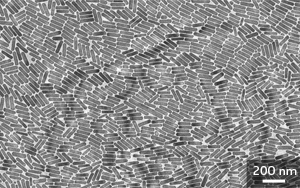The promise of purple for enhanced bioimaging

A novel type of pill-shaped nanocrystal emits the correct light frequencies for triggering and detecting many biological reactions. Reproduced, with permission, from Ref. 1 © 2014 J. Wang et al.
Labeling biomolecules with light-emitting nanoparticles is a powerful technique for observing cell movement and signaling under realistic, in vivo conditions. The small size of these probes, however, often limits their optical capabilities. In particular, many nanoparticles have trouble producing high-energy light with wavelengths in the violet to ultraviolet range, which can trigger critical biological reactions.
Now, an international team led by Xiaogang Liu from the A*STAR Institute of Materials Research and Engineering and the National University of Singapore has discovered a novel class of rare-earth nanocrystals that preserve excited energy inside their atomic framework, resulting in unusually intense violet emissions1.
Nanocrystals selectively infused, or ‘doped’, with rare-earth ions have attracted the attention of researchers, because of their low toxicity and ability to convert low-energy laser light into violet-colored luminescence emissions — a process known as photon upconversion. Efforts to improve the intensity of these emissions have focused on ytterbium (Yb) rare-earth dopants, as they are easily excitable with standard lasers. Unfortunately, elevated amounts of Yb dopants can rapidly diminish, or ‘quench’, the generated light.
This quenching probably arises from the long-range migration of laser-excited energy states from Yb and toward defects in the nanocrystal. Most rare-earth nanocrystals have relatively uniform dopant distributions, but Liu and co-workers considered that a different crystal arrangement — clustering dopants into multi-atom arrays separated by large distances — could produce localized excited states that do not undergo migratory quenching.
The team screened numerous nanocrystals with different symmetries before discovering a material that met their criteria: a potassium fluoride crystal doped with Yb and europium rare earths (KYb2F7:Eu). Experiments revealed that the isolated Yb ‘energy clusters’ inside this pill-shaped nanocrystal (see image) enabled substantially higher dopant concentrations than usual — Yb accounted for up to 98 per cent of the crystal’s mass — and helped initiate multiphoton upconversion that yielded violet light with an intensity eight times higher than previously seen.
The researchers then explored the biological applications of their nanocrystals by using them to detect alkaline phosphatases, enzymes that frequently indicate bone and liver diseases. When the team brought the nanocrystals close to an alkaline phosphate-catalyzed reaction, they saw the violet emissions diminish in direct proportion to a chemical indicator produced by the enzyme. This approach enables swift and sensitive detection of this critical biomolecule at microscale concentration levels.
“We believe that the fundamental aspects of these findings — that crystal structures can greatly influence luminescence properties — could allow upconversion nanocrystals to eventually outperform conventional fluorescent biomarkers,” says Liu.
The A*STAR-affiliated researchers contributing to this research are from the Institute of Materials Research and Engineering
Associated links
Journal information
Wang, J., Deng, R., MacDonald, M. A., Chen, B., Yuan, J. et al. Enhancing multiphoton upconversion through energy clustering at sublattice level. Nature Materials 13, 157–162 (2014).
Media Contact
All latest news from the category: Life Sciences and Chemistry
Articles and reports from the Life Sciences and chemistry area deal with applied and basic research into modern biology, chemistry and human medicine.
Valuable information can be found on a range of life sciences fields including bacteriology, biochemistry, bionics, bioinformatics, biophysics, biotechnology, genetics, geobotany, human biology, marine biology, microbiology, molecular biology, cellular biology, zoology, bioinorganic chemistry, microchemistry and environmental chemistry.
Newest articles

Combatting disruptive ‘noise’ in quantum communication
In a significant milestone for quantum communication technology, an experiment has demonstrated how networks can be leveraged to combat disruptive ‘noise’ in quantum communications. The international effort led by researchers…

Stretchable quantum dot display
Intrinsically stretchable quantum dot-based light-emitting diodes achieved record-breaking performance. A team of South Korean scientists led by Professor KIM Dae-Hyeong of the Center for Nanoparticle Research within the Institute for…

Internet can achieve quantum speed with light saved as sound
Researchers at the University of Copenhagen’s Niels Bohr Institute have developed a new way to create quantum memory: A small drum can store data sent with light in its sonic…





















